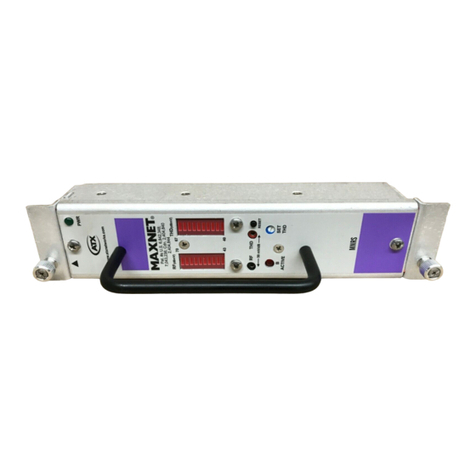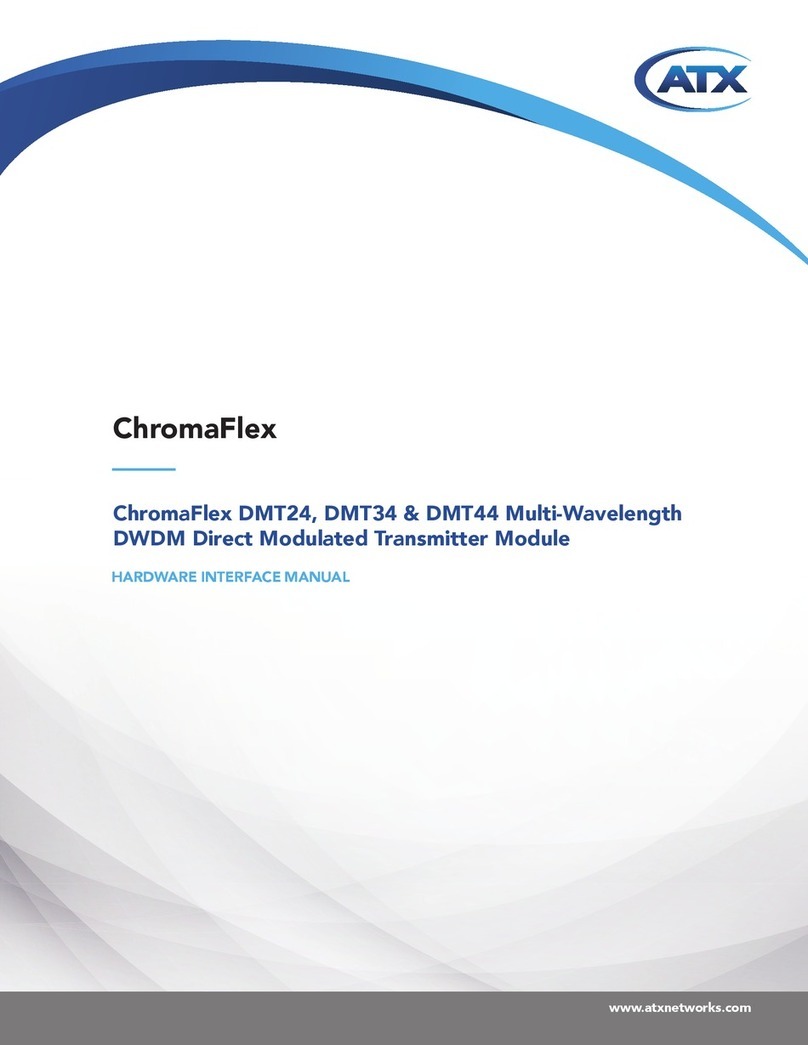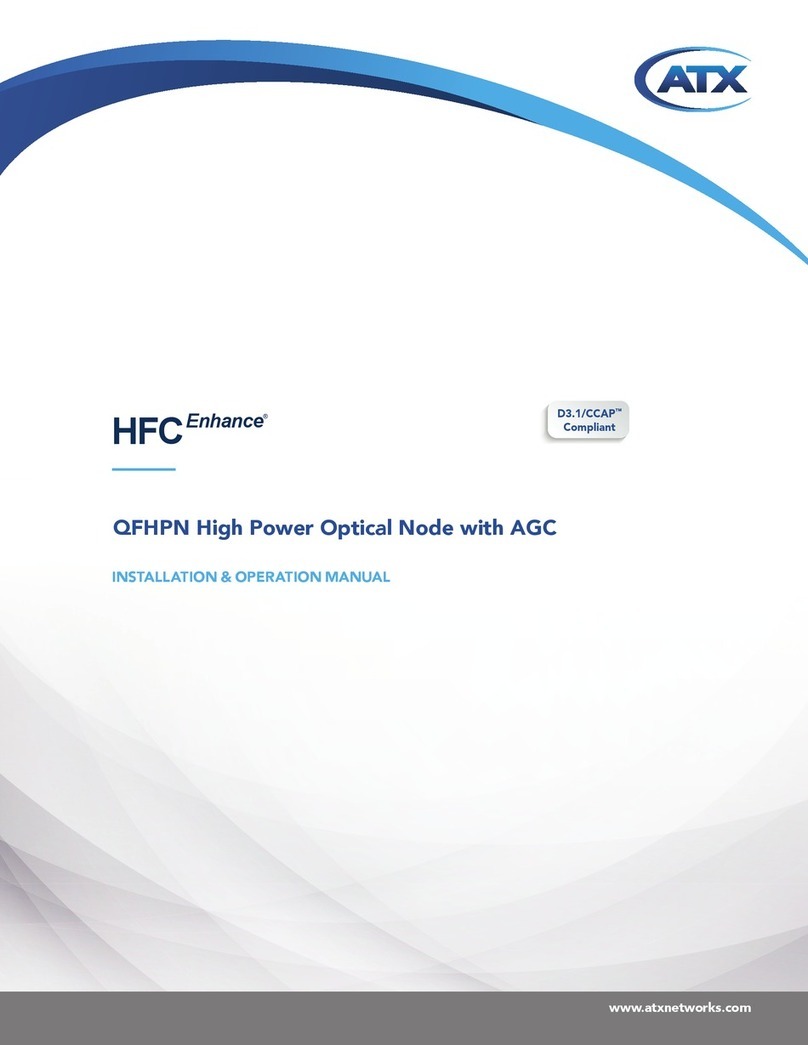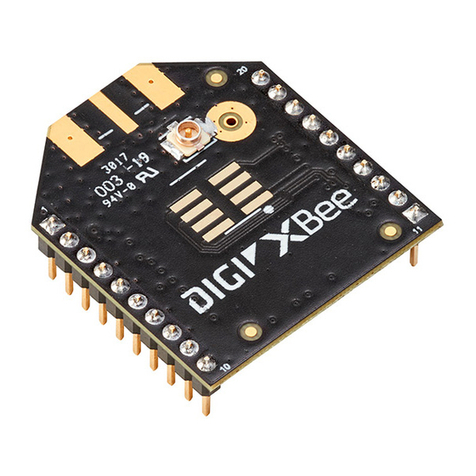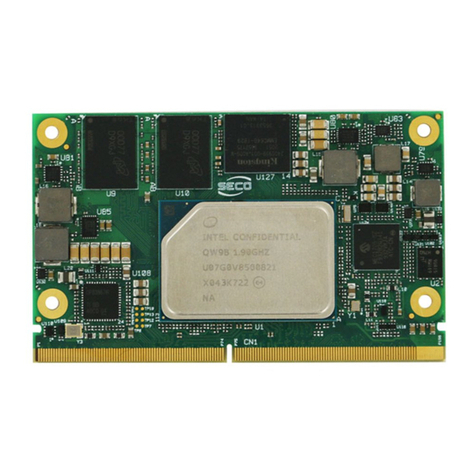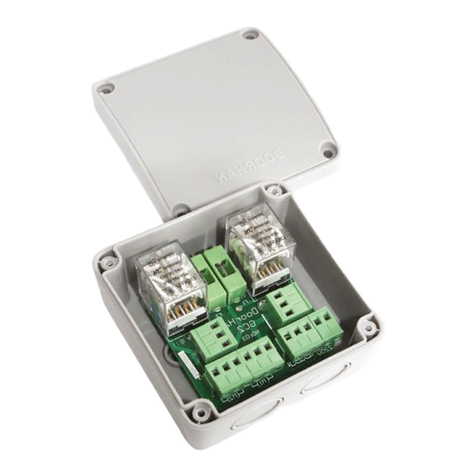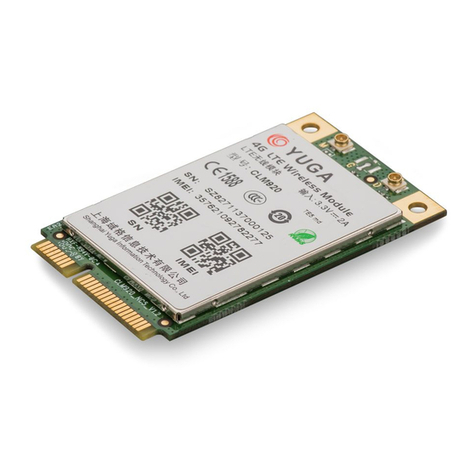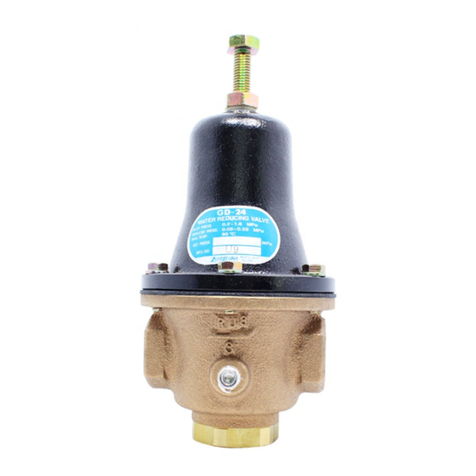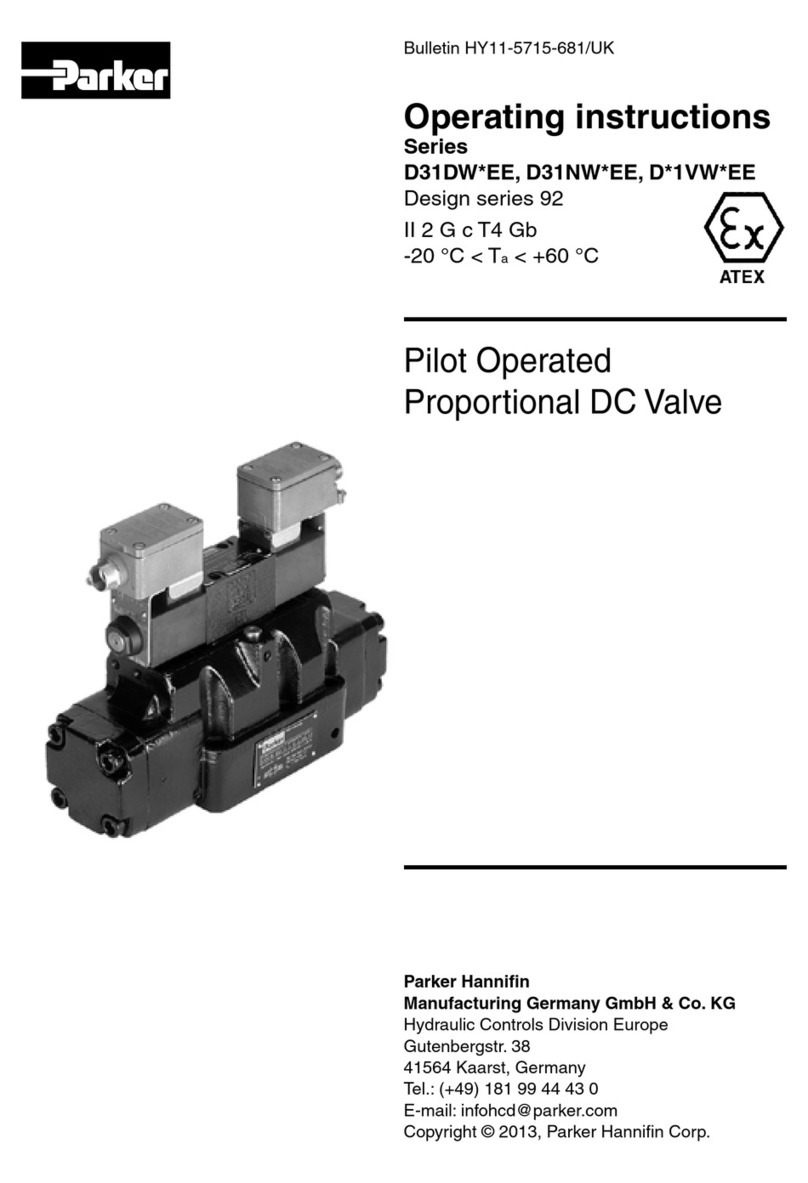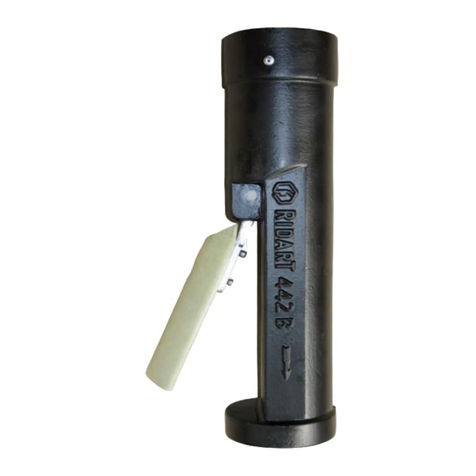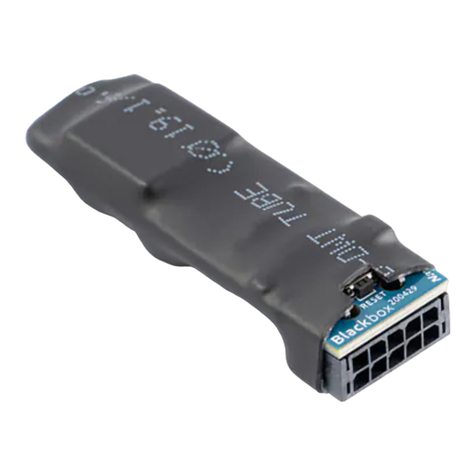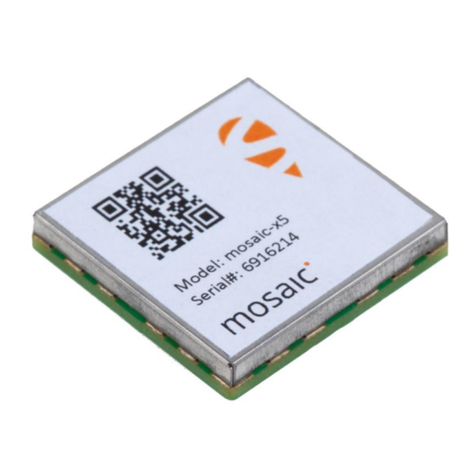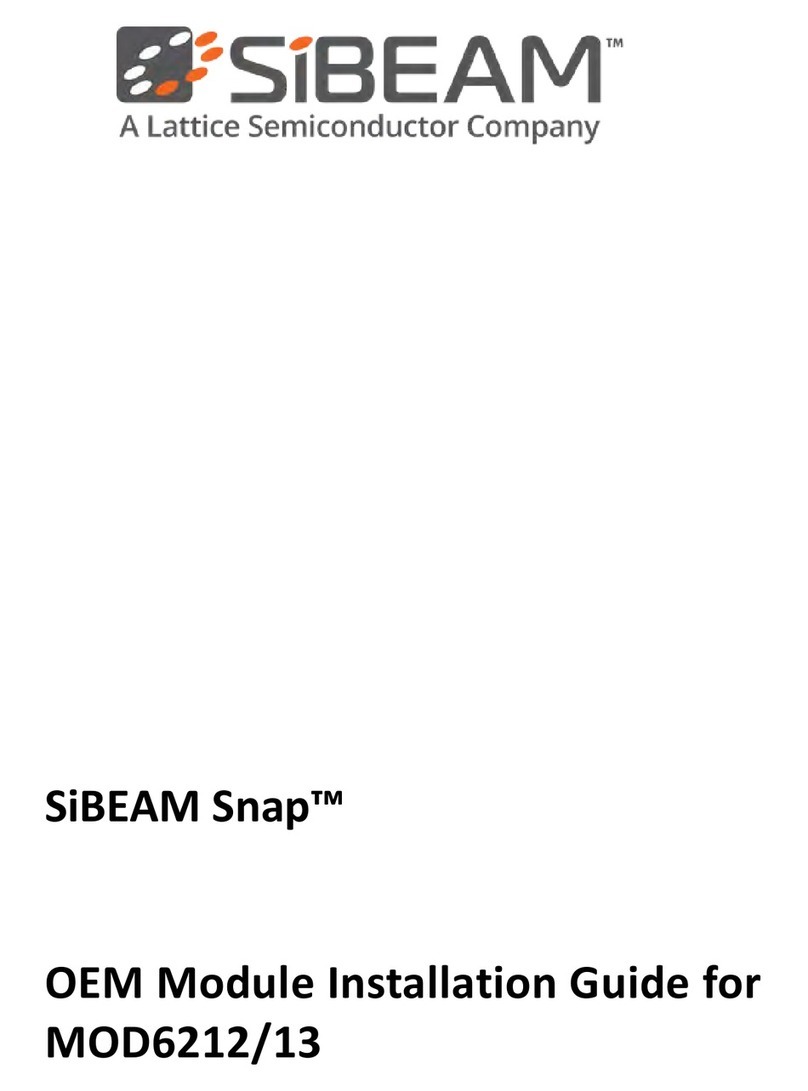ATX SignalOn N-M 18M0 Series User manual

ATX Confi dential & Proprietary
INSTALLATION & OPERATION MANUAL
RF Passive Modules
www.atxnetworks.com
www.atx.com
1.2 GHz
D3.1/CCAP
™
Compliant
SignalOn
®
Series
DISCONTINUED

ATX Condential & Proprietary
SignalOn®Series, MAXNET®, HFC Enhance®, PCI Filters®, Q-Series®& FiberLinx®are registered trademarks of ATX in the United States and/or other countries. SMACSM is a
service mark of ATX in the United States and/or other countries. Products or features contained herein may be covered by one or more U.S. or foreign patents. Other non-ATX
product and company names in this manual are the property of their respective companies.
Although every effort has been taken to ensure the accuracy of this document it may be necessary, without notice, to make amendments or correct omissions.
Specications subject to change without notice.

ATX Condential & Proprietary
TABLE OF CONTENTS
Page
About This Manual ............................................................................................................................................ iii
Admonishments ................................................................................................................................................ iii
General Safety Precautions.............................................................................................................................. iii
Certication UL/ETL/CSA Listed...................................................................................................................... iii
Standards........................................................................................................................................................... iii
List of Acronyms and Abbreviations ............................................................................................................... iv
1. GENERAL DESCRIPTION ........................................................................................................................ 1-1
1.1. Splitters/Combiners ........................................................................................................................... 1-1
1.2. Diplex Filter Module........................................................................................................................... 1-2
1.3. Condition & Monitor Module .............................................................................................................. 1-2
2. FUNCTIONAL DESCRIPTION .................................................................................................................. 2-1
3. PLANNING................................................................................................................................................. 3-1
4. OPERATION .............................................................................................................................................. 4-1
4.1. Module Applications........................................................................................................................... 4-1
5. MAINTENANCE......................................................................................................................................... 5-1
5.1. Preventive Maintenance.................................................................................................................... 5-1
6. SPECIFICATIONS ..................................................................................................................................... 6-1
7. SERVICE & SUPPORT.............................................................................................................................. 7-1
7.1. Contact ATX Networks....................................................................................................................... 7-1
7.2. Warranty Information ......................................................................................................................... 7-1
7.3. Safety ................................................................................................................................................ 7-1
SignalOn®Series – RF Passive Modules - Installation & Operation Manual i

ATX Condential & Proprietary
Index of Figures and Tables
Figures
#1 Module Label .........................................................................................................1-1
#2 Condition and Monitor Module Schematic.............................................................1-2
#3 Make-Before-Break (MBB) Splitter/Combiner Module...........................................2-1
#4 Plain Splitter/Combiner Module .............................................................................2-2
#5 Combining 16 Input Signals...................................................................................4-1
#6 Distributing Signals................................................................................................4-2
Tables
#1 Make-Before-Break (MBB) Splitter/Combiner Module Specications....................6-1
#2 Plain Splitter/Combiner Module Specications......................................................6-1
ii SignalOn®Series – RF Passive Modules - Installation & Operation Manual

ATX Confi dential & Proprietary
About This Manual
The SignalOn Series is a modular system consisting of a 4-position, 8-position, or 20-position chassis and modules for
combining and splitting of the headend signals in a CATV system. The system is designed to accommodate superior cable
management and ease of use.
Admonishments
Important safety admonishments are used throughout this manual to warn of possible hazards to persons or equipment.
An admonishment identi es a possible hazard and then explains what may happen if the hazard is not avoided. The
admonishments — in the form of Dangers, Warnings, and Cautions — must be followed at all times. These warnings are
fl agged by use of the triangular alert icon (seen below), and are listed in descending order of severity of injury or damage
and likelihood of occurrence.
Danger: Danger is used to indicate the presence of a hazard that will cause severe personal injury, death, or substantial
property damage if the hazard is not avoided.
Warning: Warning is used to indicate the presence of a hazard that can cause severe personal injury, death, or substantial
property damage if the hazard is not avoided.
Caution: Caution is used to indicate the presence of a hazard that will or can cause minor personal injury or property
damage if the hazard is not avoided.
General Safety Precautions
Warning: Never install equipment in a wet location or during a lightning storm.
Certi cation UL/ETL/CSA Listed
The SignalOn Series passive products have been tested and found to comply with the requirements of UL/CSA 60950.
Standards
The following listing is a bibliography of applicable ANSI and Bellcore documents:
MIL-STD-202 Test Methods for Electronic and Electrical Component Parts
UL 60950 Safety, Telephone Equipment
SignalOn®Series – RF Passive Modules - Installation & Operation Manual iii
PREFACE

ATX Condential & Proprietary
PREFACE
iv SignalOn®Series – RF Passive Modules - Installation & Operation Manual
List of Acronyms and Abbreviations
The acronyms and abbreviations used in this manual are detailed in the following list:
AWG American Wire Gauge
ANSI American National Standards Institute
CPE Customer Premise Equipment
CI Customer Interface
FCC Federal Communications Commission
GND Ground
MBB Make-Before-Break
MON Monitor
NID Network Interface Device
RCV Receive
XMT Transmit

ATX Condential & Proprietary
PREFACE
GENERAL DESCRIPTION
1. General Description
The SignalOn Series is a modular system allowing for combining and splitting of the headend signals in a CATV system.
The system is designed to accommodate efcient cable management, EMI shielding, and ease of use. All of these help to
facilitate easy reconguration and high performance within a dynamic headend environment.
1.1. Splitters/Combiners
Splitters and combiners are modular devices designed to slide into a chassis and secured by thumbscrews. They are available
in a plain style or pads-and-monitor style. Modules have BNC or F type connectors for customer connections. A variety of
splitters and combiners may be installed in each chassis.
1.1.1. Pads-and-Monitor Style Splitters and Combiners
Splitters and combiners with monitor ports are available with either 0 dB or 6 dB default attenuation. Module attenuation
default value, module type, and monitor information is noted on the blue label located at the top of each module. For example,
the label shown in Figure 1 indicates that this is a combiner module; it is a 3-up, 2-to-1, with on-board default attenuation of
0 dB. It also has three monitor ports all 20 dB down from the common port. Attenuation pads may be installed to change the
attenuation from 0 to 20 dB.
Pad contacts are make-before-break (MBB). This means that without an attenuator in place, the make-before-break contact
is closed, providing the on-board default attenuation value to the circuit. When an attenuator pad is inserted, the make-
before-break contacts open, routing the signal through the attenuator, replacing the on-board default attenuation value of
0 dB or 6 dB with the value of the attenuator pad. A monitor port is included on the padded modules, providing a –20 dB
reference signal with high isolation between the monitor and input ports. See schematic on each module for details.
1.1.2. Pads
The attenuation pads used in these modules are available with insertion loss values of 0 to 20 dB in 1 dB steps and are for
use in the frequency range: 5 MHz to 1,000 MHz.
1.1.2.1. Changing Attenuation Pads
When make-before-break modules are used attentuation pads may be changed without interrupting the signal. Attenuation
pad value is stamped on the front of each pad. Determine new attentuation value required. Remove the existing attentuation
pad and install a new pad with the appropriate value as follows:
1. Remove protective cover from the front of the module by loosening the thumbscrew.
2. Grasp the pad to be changed and pull it straight out of the module.
3. Position new pad in the module and press straight into place.
4. Replace protective cover on the front of the module and hand-tighten the thumbscrew.
SignalOn®Series – RF Passive Modules - Installation & Operation Manual 1-1
CHAPTER 1: GENERAL DESCRIPTION
Figure #1: Module Label
COMB
3X[2:1]
DEFLT
0dB
MON
20dB
20dB
20dB

ATX Condential & Proprietary
1.2. Diplex Filter Module
SignalOn diplex lter modules allow for passive band splitting of both forward, and reverse signals. Each module houses
three separate diplex lter circuits. All circuit connections are accessible on the rear of the module housing. Attenuator pads,
and test points similar to splitter/combiner modules are not available on this module.
1.3. Condition & Monitor Module
The condition and monitor module allows a signal to be passed through two make-before-break pad sockets before being
monitored by a –20 dB directional coupler. This allows a technician the ability to use one pad socket for padding and one pad
socket for equalization. A simplied Condition and Monitor schematic is shown in Figure 2.
1-2 SignalOn®Series – RF Passive Modules - Installation & Operation Manual
CHAPTER 1: GENERAL DESCRIPTION
Figure #2: Condition and Monitor Module Schematic
PA
DI
NPUT
OUTPU
T
EQ
MON
-20 dB

ATX Condential & Proprietary
CHAPTER 1: GENERAL DESCRIPTION
FUNCTIONAL DESCRIPTION
2. Functional Description
Figure 3 shows a Make-Before-Break (MBB) Splitter/Combiner block diagrams. Figure 4 shows a generic block diagram of
a Splitter/Combiner.
SignalOn®Series – RF Passive Modules - Installation & Operation Manual 2-1
CHAPTER 2: FUNCTIONAL DESCRIPTION
Figure #3: Make-Before_Break (MBB) Splitter/Combiner Module
8-way Splitter
COM
PORT
20 dB
MON
PORT
PAD
0 dB
DEFAULT
DETAIL (TYP 8)
5
4
3
2
1
6
7
8
SEE DETAIL
N-MS*18M0*
Dual 4-way Splitter
COM
PORT
20 dB
MON
PORT
3
2
1
4
3
2
1
4
COM
PORT
20 dB
MON
PORT
PAD
0 dB
DEFAULT
DETAIL (TYP 8)
SEE DETAIL
N-MS*24M0*
Dual 4-way Splitter/Combiner
with Monitor
COM
PORT
3
2
1
4
20 dB
MON
PORT
COM
PORT
3
2
1
4
20 dB
MON
PORT
PAD
0 dB
DEFAULT
DETAIL (TYP 8)
SEE DETAIL
N-MX*24M0*
Triple 2-way Combiner
2
1
COM
PORT
20 dB
MON
PORT 2
1
COM
PORT
20 dB
MON
PORT 2
1
COM
PORT
20 dB
MON
PORT
PAD
0 dB
DEFAULT
DETAIL (TYP 6)
SEE DETAIL
N-MC*32M0*
8-way Combiner
COM
PORT
20 dB
MON
PORT
PAD
0 dB
DEFAULT
DETAIL (TYP 8)
5
4
3
2
1
6
7
8
SEE DETAIL
N-MC*18M0*
Dual 4-way Combiner
COM
PORT
3
2
1
4
20 dB
MON
PORT
COM
PORT
3
2
1
4
20 dB
MON
PORT
PAD
0 dB
DEFAULT
DETAIL (TYP 8)
SEE DETAIL
N-MC*24M0*
Triple 2-way Combiner
2
1
COM
PORT
20 dB
MON
PORT 2
1
COM
PORT
20 dB
MON
PORT 2
1
COM
PORT
20 dB
MON
PORT
PAD
0 dB
DEFAULT
DETAIL (TYP 6)
SEE DETAIL
N-MC*32M0*

ATX Condential & Proprietary
2-2 SignalOn®Series – RF Passive Modules - Installation & Operation Manual
CHAPTER 2: FUNCTIONAL DESCRIPTION
Plain 8-way Splitter/Combiner
COM
PORT
5
4
3
2
1
6
7
8
N-MP*18*
Plain 4-way Splitter/Combiner
COM
PORT
3
2
1
4
N-MP*14*
Plain Dual 4-way Splitter/
Combiner
COM
PORT
3
2
1
4
COM
PORT
3
2
1
4
N-MP*24*
COM
PORT
2
1
Plain 2-way Splitter/Combiner
N-MP*12*
Plain Triple 2-way Splitter/
Combiner
COM
PORT
2
1
COM
PORT
2
1
COM
PORT
2
1
N-MP*32*
Figure #4: Plain Splitter/Combiner Module

ATX Condential & Proprietary
CHAPTER 2: FUNCTIONAL DESCRIPTION
PLANNING
3. Planning
Several things need to be considered when planning for the location of the SignalOn Series chassis. Some of these are:
• Chassis should only be installed in restricted access areas (dedicated equipment rooms, equipment closets, etc.) in
accordance with Articles 110-16, 110-17, and 110-18 of the National Electrical Code, ANSI/NFPA 70.
• When using open relay-rack style network bays, spacing between bays and at lineup ends may be required depending
on the quantity and type of coaxial cable entering the bays. When spacing bays 0, 5, or 10 inches, verify that vertical
jumper rings will t between bays.
• A fully loaded chassis may terminate up to two-hundred cables. Consideration should be given to the number of chassis
installed in a rack to prevent cable congestion.
• Allow sufcient room for cable management behind the chassis. Also leave sufcient vertical and horizontal cable
pathways above and below the chassis.
SignalOn®Series – RF Passive Modules - Installation & Operation Manual 3-1
CHAPTER 3: PLANNING

ATX Confi dential & Proprietary
3-2 SignalOn®Series – RF Passive Modules - Installation & Operation Manual
CHAPTER 3: PLANNING
This page left intentionally blank.

ATX Condential & Proprietary
CHAPTER 3: PLANNING
OPERATION
4. Operation
There are no specic operating instructions for the passive components covered in this user manual. Once they are installed
in their respective chassis, they perform their designated RF passive signal management functions (splitting or combining)
without further attention.
4.1. Module Applications
4.1.1. Combining
In traditional combining applications (Figure 18), the SignalOn Series modules mount conveniently at the top of a modulator
bay.
SignalOn®Series – RF Passive Modules - Installation & Operation Manual 4-1
CHAPTER 4: OPERATION
8 x 1
2 x 1
SIGNAL
PROCESSOR
#1
SIGNAL
PROCESSOR
#8
8 x 1
SIGNAL
PROCESSOR
#9
SIGNAL
PROCESSOR
#16
TO
DISTRIBUTION
NETWORK
Figure #5: Combining 16 Input Signals

ATX Condential & Proprietary
4.1.2. Distribution
For traditional distribution applications (see example in Figure 19), the SignalOn Series modules provide the splitting function
with multiple splitting ratios and a high-density rack mount solution. Splitting modules are available with a variety of splitting
ratios.
4-2 SignalOn®Series – RF Passive Modules - Installation & Operation Manual
CHAPTER 4: OPERATION
COMBINING
NETWORK
LASER XMIT
#1
LASER XMIT
#2
LASER XMIT
#3
LASER XMIT
#4
2 x 1
4 x 1
4 x 1
NODE
NODE
NODE
NODE
TO OTHER LASER
TRANSMITTERS
Figure #6: Distributing Signals

ATX Condential & Proprietary
MAINTENANCE
5. Maintenance
Maintenance requirements for the SignalOn Series passive components covered in this manual are minimal, consisting
merely of periodic cleaning.
5.1. Preventive Maintenance
NOTE: There are no customer serviceable parts in any of the components in this system; return all failed components to ATX
Networks for service or repair. Opening the module voids all applicable warranties.
The outside of the chassis and passive components should be cleaned during routine ofce equipment maintenance. Care
must be taken to prevent dust and dirt from getting into any of the coaxial jacks or connectors.
For any repairs, contact ATX Networks at the telephone number listed in Section 9, Service & Support, of this manual.
CHAPTER 4: OPERATION
SignalOn®Series – RF Passive Modules - Installation & Operation Manual 5-1
CHAPTER 5: MAINTENANCE

ATX Confi dential & Proprietary
5-2 SignalOn®Series – RF Passive Modules - Installation & Operation Manual
CHAPTER 5: MAINTENANCE
This page left intentionally blank.

ATX Condential & Proprietary
SPECIFICATIONS
6. Specications
Physical and environmental specications are noted in Table 1. Module specications are given in Table 2, through
Table 16.
CHAPTER 5: MAINTENANCE
SignalOn®Series – RF Passive Modules - Installation & Operation Manual 6-1
CHAPTER 6: SPECIFICATIONS
Table #1: Make-Before-Break (MBB) Splitter/Combiner Module Specications
Table #2: Plain Splitter/Combiner Module Specications
SPECIFICATIONS 8-WAY WITH TP & MBB DUAL 4-WAY WITH TP & MBB TRIPLE 2-WAY WITH TP & MBB
N-M**18M0 N-M**18M0H N-M**24M0 N-M**24M0H N-M**32M0 N-M**32M0H
FREQUENCY RANGE Fmin - Fmax 5 MHz 1002 MHz 5 MHz 1218 MHz 5 MHz 1002 MHz 5 MHz 1218 MHz 5 MHz 1002 MHz 5 MHz 1218 MHz
MEASUREMENT FREQUENCY Min (dB) Max (dB) Min (dB) Max (dB) Min (dB) Max (dB) Min (dB) Max (dB) Min (dB) Max (dB) Min (dB) Max (dB)
INSERTION LOSS
5 MHz 11.9 12.9 9 11 8.1 9.1 6.3 8.3 4.1 5.1 2.7 4.7
50 MHz 11.9 12.9 9.1 11.1 8.1 9.1 6.4 8.4 4.1 5.1 2.7 4.7
550 MHz 11.9 12.9 10.3 12.3 8.1 9.1 6.9 8.9 4.1 5.1 3.2 5.2
870 MHz 11.9 13.1 11.1 13.1 8.1 9.3 7.3 9.3 4.1 5.3 3.5 5.5
1002 MHz 11.9 13.1 11.5 13.5 8.1 9.3 7.5 9.5 4.1 5.3 3.6 5.6
1218 MHz 12 14 7.9 9.7 3.8 5.8
FLATNESS 50-Fmax MHz < 1.0 < 0.7 < 1.0 < 0.6 < 1.0 < 0.5
TEST POINT 5-Fmax MHz 19.2 20.8 19 21 19.2 20.8 19 21 19.2 20.8 19 21
RETURN LOSS
5-50 MHz 16 16 16 16 16 16
50-1002 MHz 20 20 20 20 20 20
1002-1218 MHz 18 18 18
NOTE:
** - 1st * = S (splitter), C (combiner) or X (one splitter, one combiner); 2nd * = F or B (BNC) connectors. BNC not available in “H” (1218 MHz) versions.
SPECIFICATIONS PLAIN 8-WAY PLAIN SINGLE/DUAL 4-WAY PLAIN SINGLE/TRIPLE 2-WAY
N-MP*18 N-MPF18H N-MP*14 / N-MP*24 N-MPF24H N-MP*12 / N-MP*32 N-MPF32H
FREQUENCY RANGE Fmin - Fmax 5 MHz 1002 MHz 5 MHz 1218 MHz 5 MHz 1002 MHz 5 MHz 1218 MHz 5 MHz 1002 MHz 5 MHz 1218 MHz
MEASUREMENT FREQUENCY Min (dB) Max (dB) Min (dB) Max (dB) Min (dB) Max (dB) Min (dB) Max (dB) Min (dB) Max (dB) Min (dB) Max (dB)
INSERTION LOSS
5 MHz 11.1 12.1 8.5 10.5 7 7.8 5.5 7.5 3.5 4.3 3 4
50 MHz 11.1 12.1 8.6 10.6 7 7.8 5.5 7.5 3.5 4.3 3 4
550 MHz 11.1 12.1 9.4 11.4 7 7.8 5.7 7.7 3.5 4.3 3.3 4.3
870 MHz 11.1 12.1 9.9 11.9 7 7.8 5.9 7.9 3.5 4.3 3.4 4.4
1002 MHz 11.1 12.1 10.1 12.1 7 7.8 5.9 7.9 3.5 4.3 3.5 4.5
1218 MHz 10.5 12.5 6 8 3.6 4.6
FLATNESS 50-Fmax MHz < 1.0 < 0.6 < 1.0 < 0.5 < 1.0 < 0.5
RETURN LOSS
5-50 MHz 20 18 20 18 20 18
50-1002 MHz 20 20 20 20 20 20
1002-1218 MHz 18 18 18
NOTE:
* = F or B (BNC) connectors.

ATX Condential & Proprietary
6-2 SignalOn®Series – RF Passive Modules - Installation & Operation Manual
CHAPTER 6: SPECIFICATIONS

ATX Condential & Proprietary
SERVICE & SUPPORT
9. Service & Support
9.1. Contact ATX Networks
Please contact ATX Technical Support for assistance with any ATX products. Please contact ATX to obtain a valid RMA
number for any ATX products that require service and are in or out-of-warranty before returning a failed module to ATX.
TECHNICAL SUPPORT
Tel: 289.204.7800 – press 1
Toll-Free: 866.YOUR.ATX (866.968.7289) USA & Canada only
Email: [email protected]
SALES ASSISTANCE
Tel: 289.204.7800 – press 2
Toll-Free: 866.YOUR.ATX (866.968.7289) USA & Canada only
Email: [email protected]
FOR HELP WITH AN EXISTING ORDER
Tel: 289.204.7800 – press 3
Toll-Free: 866.YOUR.ATX (866.968.7289) USA & Canada only
Email: [email protected]
Web: www.atx.com
9.2. Warranty Information
All of ATX Networks’ products have a 1-year warranty that covers manufacturer’s defects or failures.
9.3. Safety
IMPORTANT! FOR YOUR PROTECTION, PLEASE READ THE FOLLOWING:
WATER AND MOISTURE: Care should be taken so that objects do not fall and liquids are not spilled into the enclosure
through openings.
POWER SOURCES: The device should be connected to a power supply only of the type described in the operating
instructions or as marked on the device.
GROUNDING OR POLARIZATION: Precautions should be taken so that the grounding or polarization means of the device
is not defeated.
POWER CORD PROTECTION: Power supply cords should be routed so that they are not likely to be pinched by items
placed upon or against them, paying particular attention to cords at plugs, convenience receptacles, and the point where
they exit from the device.
SERVICING: The user should not attempt to service the device beyond that described in the operating instructions. All other
servicing should be referred to qualied service personnel.
FUSING: If your device is equipped with a fused receptacle, replace only with the same type fuse. Refer to replacement text
on the unit for correct fuse type.
CHAPTER 6: SPECIFICATIONS
SignalOn®Series – RF Passive Modules - Installation & Operation Manual 7-1
CHAPTER 7: SERVICE & SUPPORT

ATX Confi dential & Proprietary
ISO
9001:15
REGISTERED
www.atx.com
Rev. 01/20 (ANW0842)
ATX Networks
© 2020 by ATX Networks Corp. and its affiliates (collectively “ATX Networks Corp.”).
All rights reserved. This material may not be published, broadcast, rewritten, or
redistributed. Information in this document is subject to change without notice.
This manual suits for next models
13
Table of contents
Other ATX Control Unit manuals
Popular Control Unit manuals by other brands
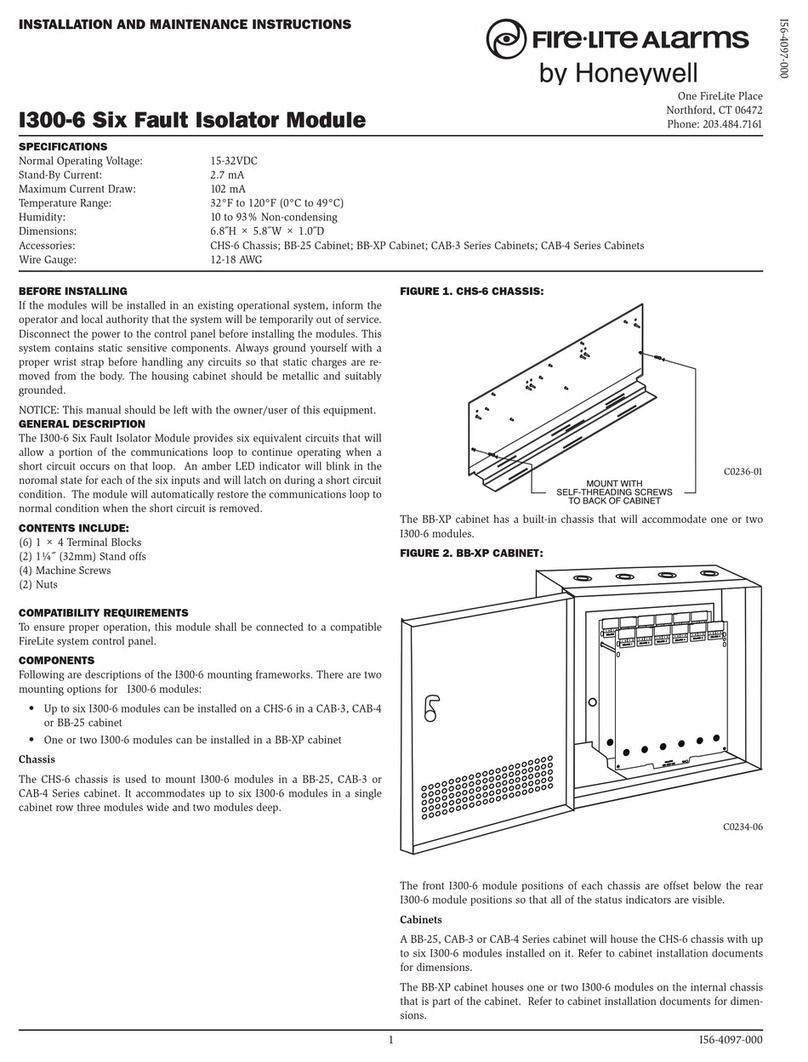
Fire-Lite Alarms
Fire-Lite Alarms I300-6 Installation and maintenance instructions
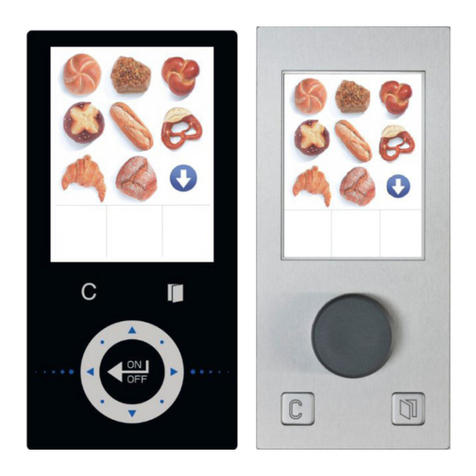
WIESHEU
WIESHEU Exclusive Original operating instructions

Akytec
Akytec PRM-X.1 user guide
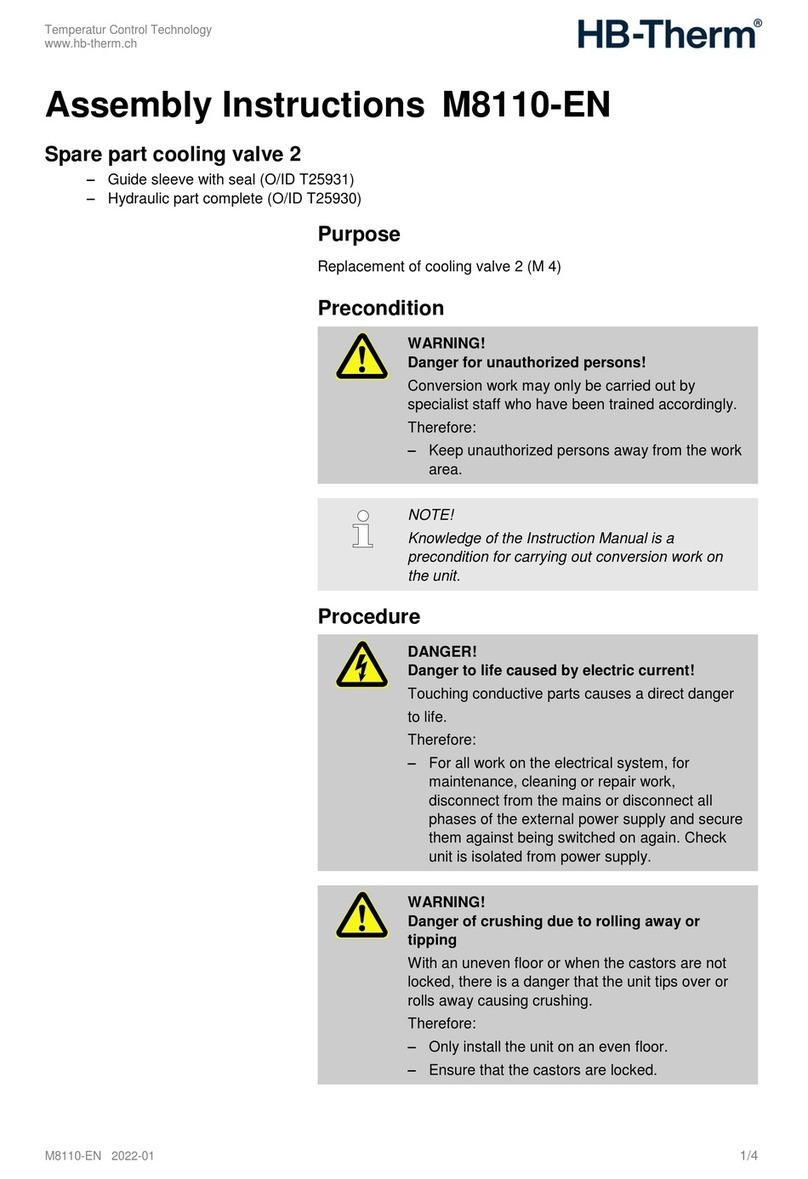
HB-THERM
HB-THERM M8110-EN Assembly instructions
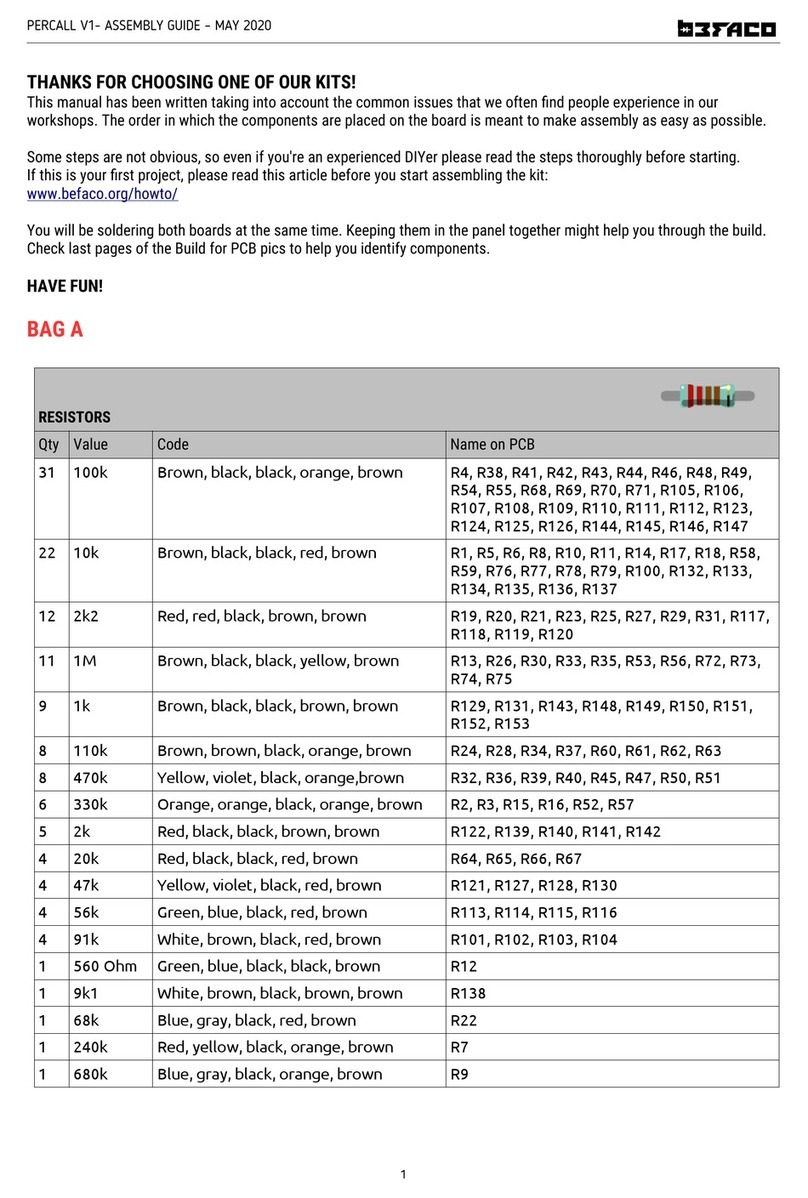
Befaco
Befaco PERCALL V1 Assembly guide

Siemens
Siemens HLIM Installation instructions manual
